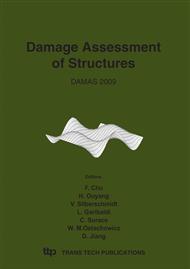p.261
p.269
p.277
p.285
p.291
p.299
p.305
p.313
p.327
Development of Many-Angular Pin Type Load Cell for a Overload Limiter of a Movable Crane
Abstract:
An overload limiter is used to prevent its overturning accident during an operating of a movable crane. Recently the indirectly measuring method, which measures hoisting load and overturning moment of overload limiter, demands instead of the existing method, which measures only hoisting load. The indirectly measuring method is how to conduct the hoisting load and overturning moment as measuring the load of hydraulic cylinder for a luffing driving of boom. So we need to develop the many-angular pin type load cell with the measuring angle of ±10 degree instead of the existing load cell with the measuring angle of ±2 degree. In this study we conducted the finite element analysis in order to evaluate the effect of the aspect ratio of measuring cross section on the measuring limit of the load cell to develop the many-angular pin type load cell. For this investigation, the aspect ratio of measuring cross section and load applying angle were adopted as design parameters and the stresses of measuring part were evaluated for each parameter.
Info:
Periodical:
Pages:
291-298
Citation:
Online since:
June 2009
Authors:
Keywords:
Price:
Сopyright:
© 2009 Trans Tech Publications Ltd. All Rights Reserved
Share:
Citation:


